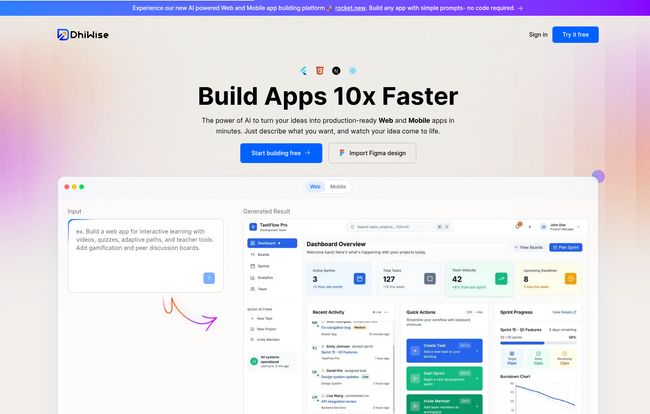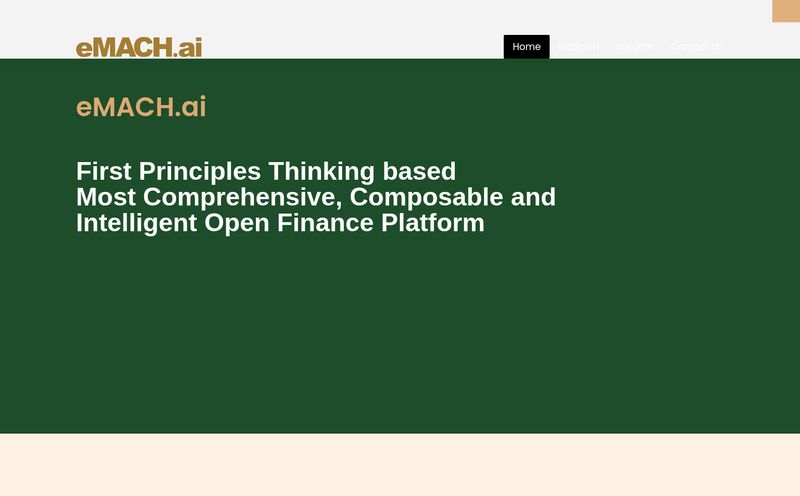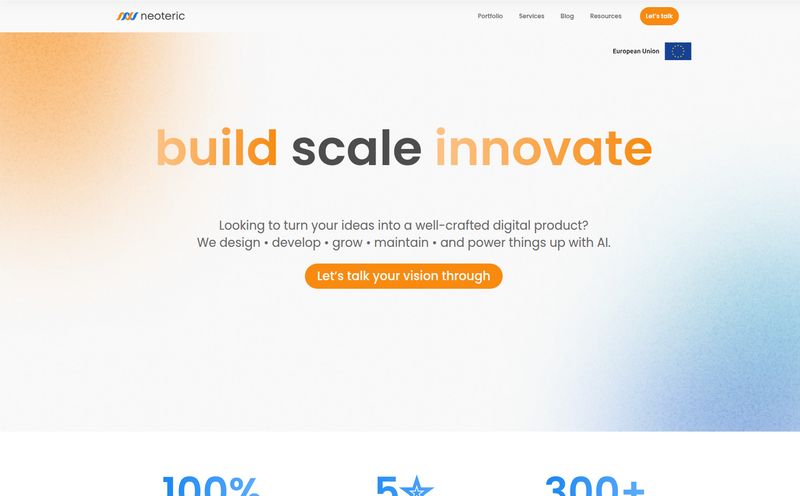If you've been in the digital space for more than a few years, you've seen the cycle. A new tool comes along, promising to 'revolutionize' your workflow, '10x your productivity', and solve world hunger while it's at it. We've all been burned by hype before. So when I first heard about DhiWise and its claim to build full-stack apps from a simple prompt or a Figma file, my professional skepticism kicked in. Hard.
We're in the thick of the no-code revolution, and while platforms like Webflow and Bubble have changed the game for websites and certain types of apps, there's always been a kind of glass ceiling. The moment you need real, scalable, custom-coded backend logic or a truly native mobile app, you hit a wall. You're back to the traditional—and often painfully slow—development cycle. You know the one. The endless back-and-forth between designer and developer, where pixel-perfect dreams go to die in a sea of technical constraints.
But DhiWise is... different. It’s not trying to be just another no-code builder. I think of it more like an AI-powered sous-chef for developers and product teams. It doesn't cook the whole meal, but it does all the tedious chopping, prepping, and organizing, so the head chef (your developer) can focus on the creative, complex parts. And that, my friends, is where things get interesting.
So, What Exactly is DhiWise?
At its core, DhiWise is an AI-powered application development platform. That's the marketing speak. In human terms, it's a tool that helps you build web and mobile applications incredibly fast. It does this in two primary ways: by using AI to generate an application from a text prompt, or by converting your existing Figma designs into high-quality, developer-ready code. It’s not about trapping you in a proprietary system; it's about giving you a massive head start by generating clean source code for modern frameworks like React, Flutter, Kotlin (for Android), and Swift (for iOS). You get the code, you own the code. A huge plus in my book.
The AI-Powered Prompt: From Idea to UI in a Flash
Okay, this is the part that feels like science fiction. The 'Rocket-build' feature, as they call it, lets you describe the app you want in plain English. For instance, the image on their homepage shows a prompt like, "Build a web app for interactive learning with video lessons, quiz tools... Add gamification and post-discussion boards."
And then... it just builds it. Or at least, it builds the front-end structure, the components, the screens. A generated dashboard appears with charts, tables and metrics. When I first saw this, I thought, 'Yeah, right. A gimmick.' But after playing around with it, its surprisingly capable. It's not going to write complex business logic for you, but for generating the entire UI scaffolding of an application in minutes? It's mind-blowing. It takes the most time-consuming part of front-end development and automates it.

Visit DhiWise
This is a game-changer for creating Minimum Viable Products (MVPs) or rapid prototypes. You can test an idea and have a tangible, clickable interface to show stakeholders or potential users in an afternoon. That's a superpower.
The Figma to Code Feature: A Designer's Dream (and a Developer's Relief)
For me, this is the real meat and potatoes. The AI prompt is flashy, but the Figma-to-code conversion solves a chronic industry problem. The handoff. Designers spend weeks in Figma crafting beautiful, functional interfaces, only to see them get lost in translation when a developer has to manually recreate every component, every spacing rule, every state.
DhiWise connects directly to your Figma file. It doesn't just slice images; it intelligently identifies your design components—buttons, forms, cards, etc.—and converts them into clean, modular code. It even attempts to create responsive designs that work across different screen sizes. Is it perfect every single time? Of course not. You'll still need a developer to review, tweak, and wire up the complex logic. But it eliminates hundreds of hours of tedious, soul-crushing grunt work. It turns the design file into a living blueprint for the final product, not just a static picture of it.
But Is the Code Any Good? Let's Talk Technical Debt.
This is the question that keeps seasoned developers up at night. Most code generators and no-code platforms produce what we politely call 'spaghetti code.' It works, kinda, but it's a nightmare to maintain, update, or scale. Trying to add a new feature is like playing Jenga with a plate of pasta. This is called technical debt, and it can kill a project down the line.
DhiWise seems acutely aware of this. One of their main selling points is the quality of the generated code. They emphasize that it's clean, modular, and reusable. From what I've seen, they're not lying. The code is well-structured, separating logic from UI, and using common patterns that any React or Flutter developer would recognize. Because you get full ownership of the source code, you're not locked into their platform. You can take the generated code, open it in your favorite editor, and build on it like you would with any other project. This single fact elevates it from a simple 'builder' to a professional development tool.
The Not-So-Shiny Bits: A Realistic Look
Look, no tool is a silver bullet. While I'm genuinely impressed, it's important to be realistic about the limitations.
- Reliance on the AI: The initial app generation is only as good as the AI's interpretation of your design or prompt. You can't just blindly trust it. A human with a good eye for design and code is still essential to verify and refine the output.
- The Learning Curve: While the basics are simple, unlocking the full potential for advanced customization and connecting to your own backend APIs will take some time. It’s a professional tool, and like any pro tool, you have to learn its intricacies.
- Potential Limitations: The platform is constantly evolving. It may not support every single niche framework or highly specialized feature you can dream of. For 90% of web and mobile apps, it's probably more than enough. For that last 10% of hyper-complex, edge-case projects, you might still need to build from scratch.
But honestly, these feel less like deal-breakers and more like reasonable trade-offs for the incredible speed you're gaining.
Who Is DhiWise Actually For?
I see a few groups getting massive value here:
Startups and Solopreneurs: Need to get an MVP out the door yesterday? This is your weapon. It slashes your time-to-market and lets you validate ideas before sinking a ton of cash into development.
Digital Agencies: Imagine being able to build high-fidelity, functional prototypes for clients in days instead of weeks. You can iterate faster, win more pitches, and make your development team way, way happier by automating the boring stuff.
Enterprise Teams: For large organizations, the benefits are about productivity and standardization. You can enforce a consistent design system, ensure all new projects are built on a secure and clean codebase, and free up your expensive senior developers to work on high-value problems instead of building yet another login screen.
What About the Price Tag?
This is always the big question. When a tool is this powerful, you expect a hefty price. According to their website, DhiWise actually has a pretty accessible model. They offer a Free plan which is great for individuals and small projects to get their feet wet. For more serious work, they have a Business plan with custom pricing. This makes sense—the needs of a large enterprise are vastly different from a small agency, and the pricing should reflect that value. The 'contact us' for enterprise model is pretty standard and allows them to build a package around specific needs like enterprise-grade security and dedicated support.
Frequently Asked Questions about DhiWise
- 1. Is DhiWise completely no-code?
- Not exactly, and that's its strength. It's more of a 'pro-code' or 'low-code' platform. It automates the generation of code, but the output is real, editable source code that developers can work with. You're not stuck in a black box.
- 2. Can I get the source code for my application?
- Yes! This is one of its biggest selling points. You get full ownership of the generated code for whatever framework you choose (React, Flutter, etc.). No vendor lock-in.
- 3. What technologies does DhiWise support?
- It supports a range of modern technologies. For frontend, that includes React for web, and natively with Swift for iOS and Kotlin for Android. They also support cross-platform development with Flutter.
- 4. How does DhiWise compare to something like Bubble or Webflow?
- Bubble and Webflow are primarily self-contained, visual development environments. DhiWise is different because it's a code generator. It's less about building inside DhiWise and more about using DhiWise to accelerate a traditional coding workflow.
- 5. Is the AI generation reliable for complex apps?
- It's a fantastic starting point. It can reliably generate the entire UI and component structure. For complex business logic, database integrations, and API connections, you'll still need a developer to step in and write that custom code. It handles the 'what it looks like' part, not the 'deeply complex thinking' part.
- 6. What about security for enterprise applications?
- This is a major focus for them. The platform emphasizes 'enterprise-grade security' and since it generates clean, standard code, it's easier to audit and secure than the proprietary code of many 'black box' builders.
Final Thoughts: Is DhiWise Worth the Hype?
After diving in, my initial skepticism has mostly melted away, replaced by a sort of pragmatic excitement. No, DhiWise is not going to put good developers out of a job. But it is going to make them exponentially more powerful.
It's a force multiplier. It automates the 80% of development that is repetitive and tedious, freeing up human minds to focus on the 20% that requires creativity, problem-solving, and architectural genius. It successfully bridges the chasm between design and development in a way I haven't seen before. The ability to go from a simple idea or a Figma file to a fully-coded, high-quality front-end in minutes is, frankly, astounding.
So, is it worth the hype? If the hype is about replacing developers, no. But if the hype is about giving them—and their entire teams—superpowers? Then yeah. I think it is.



